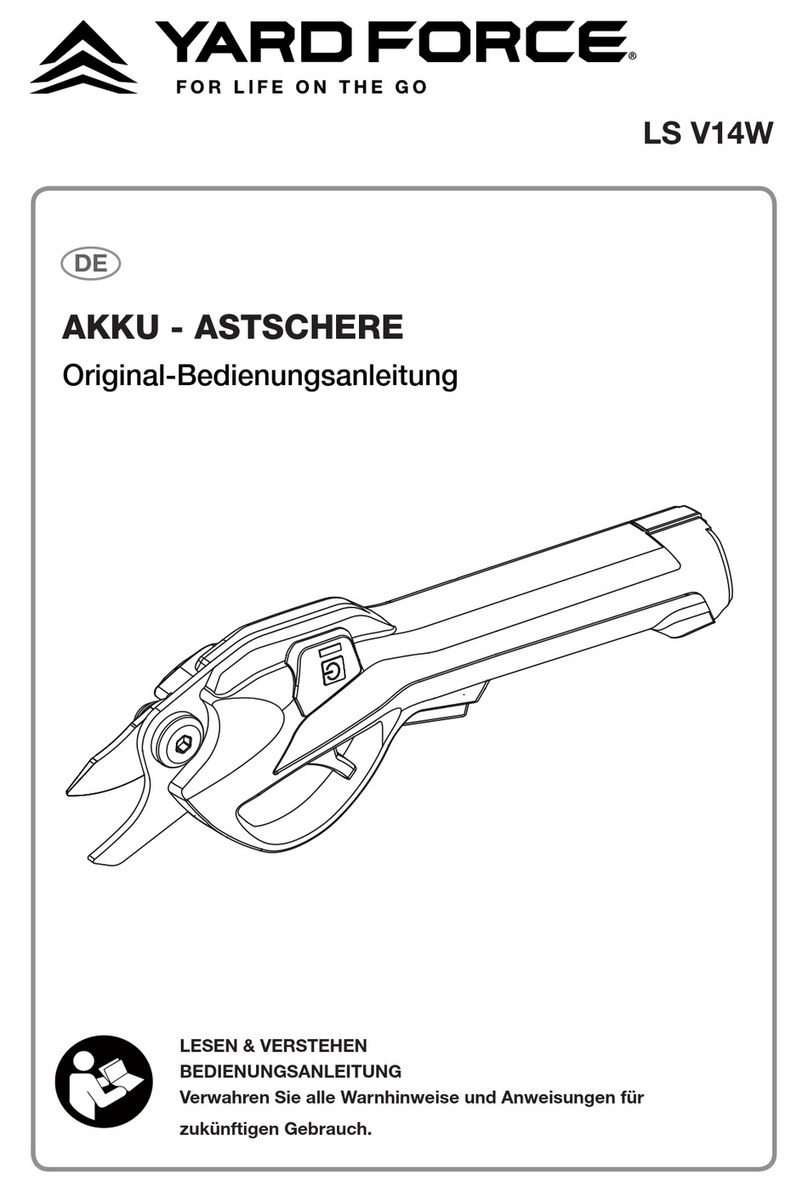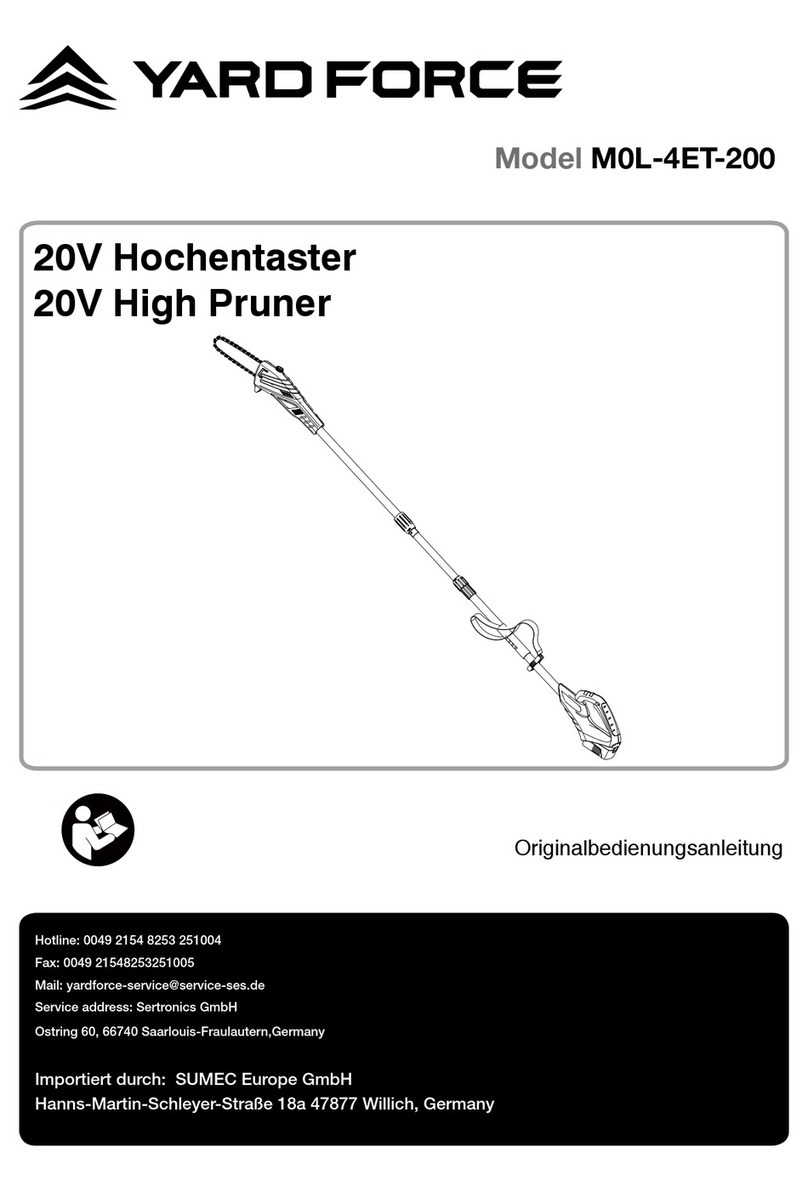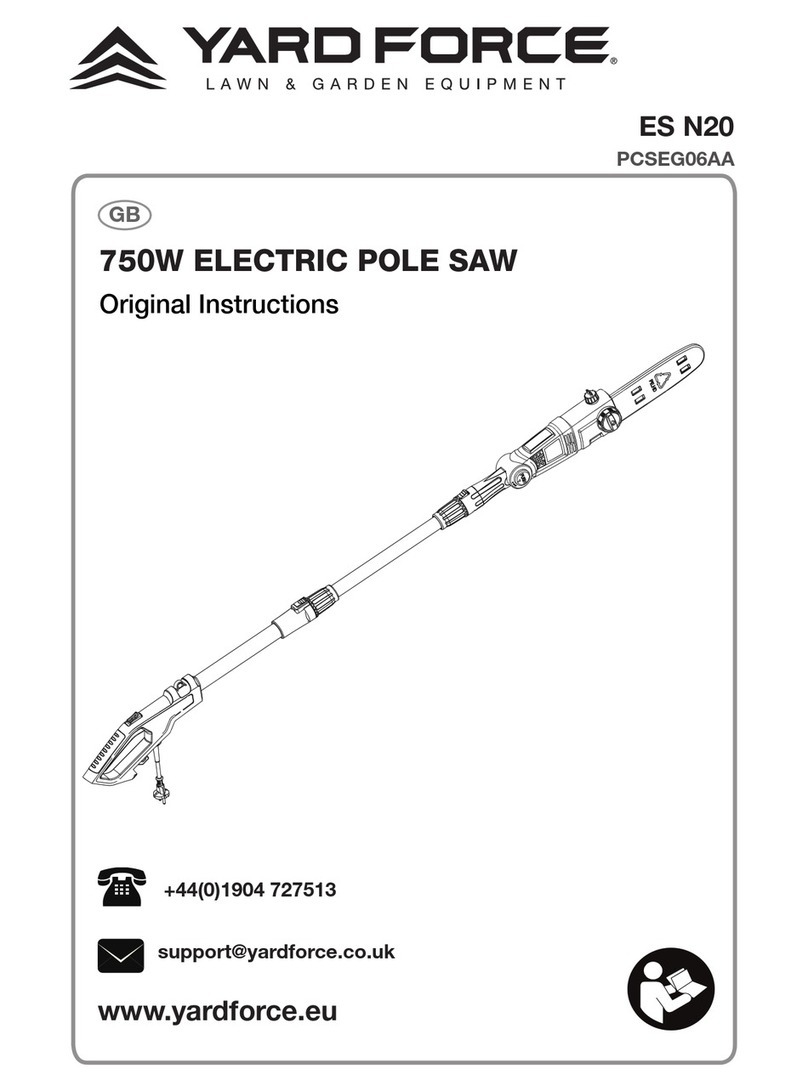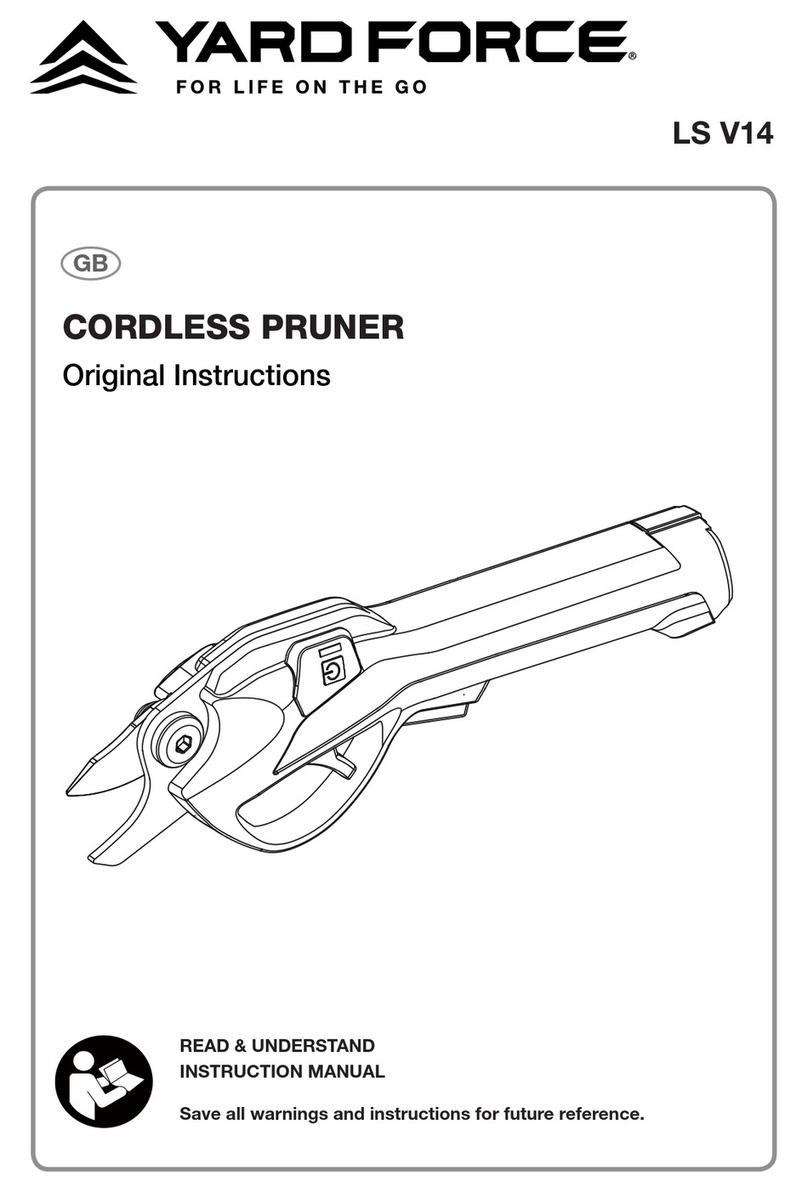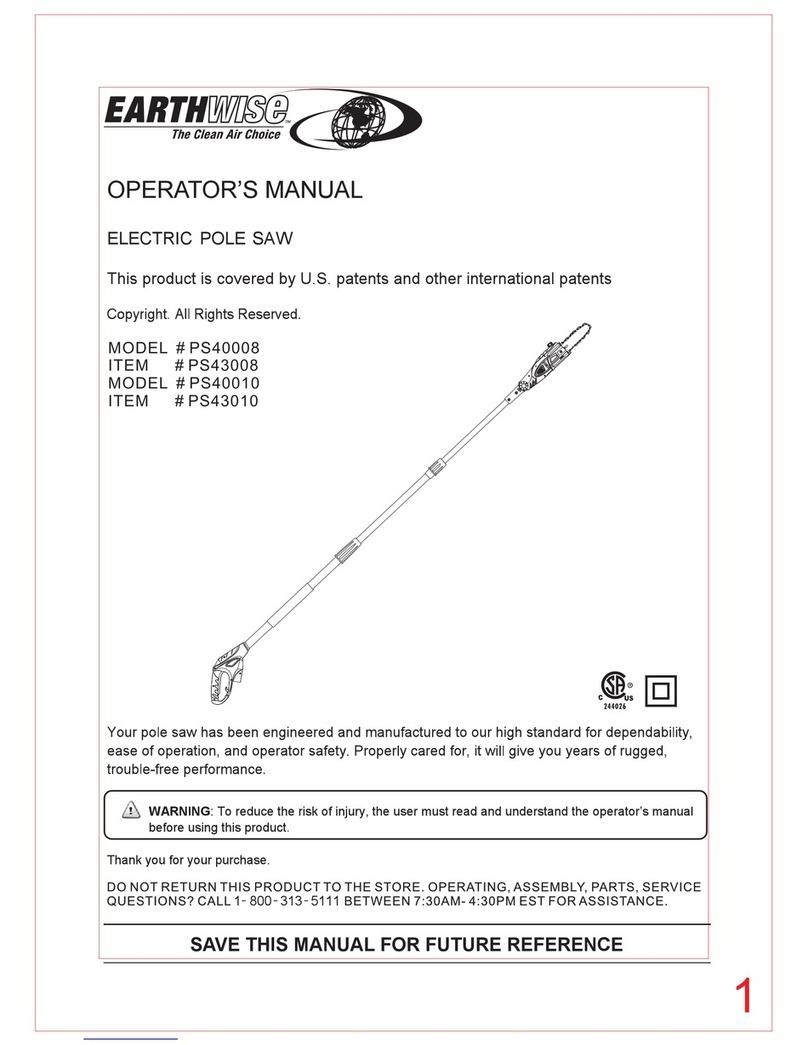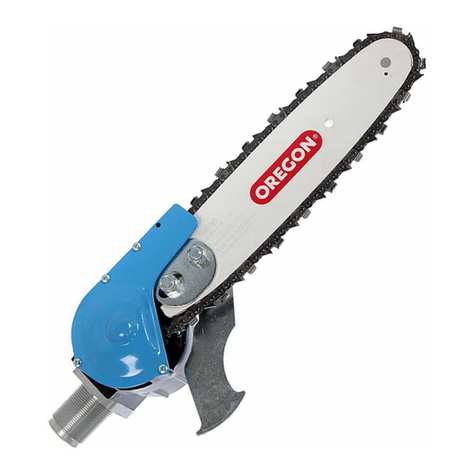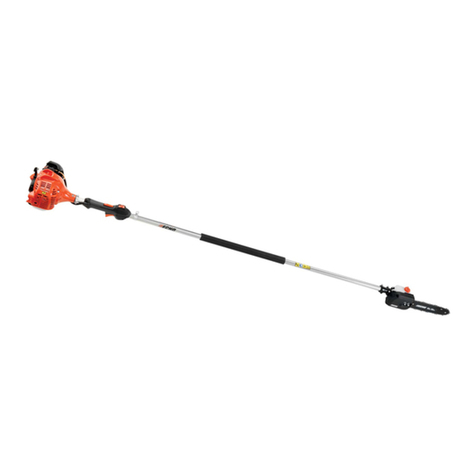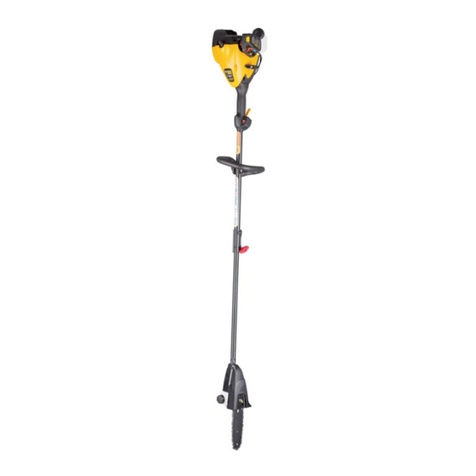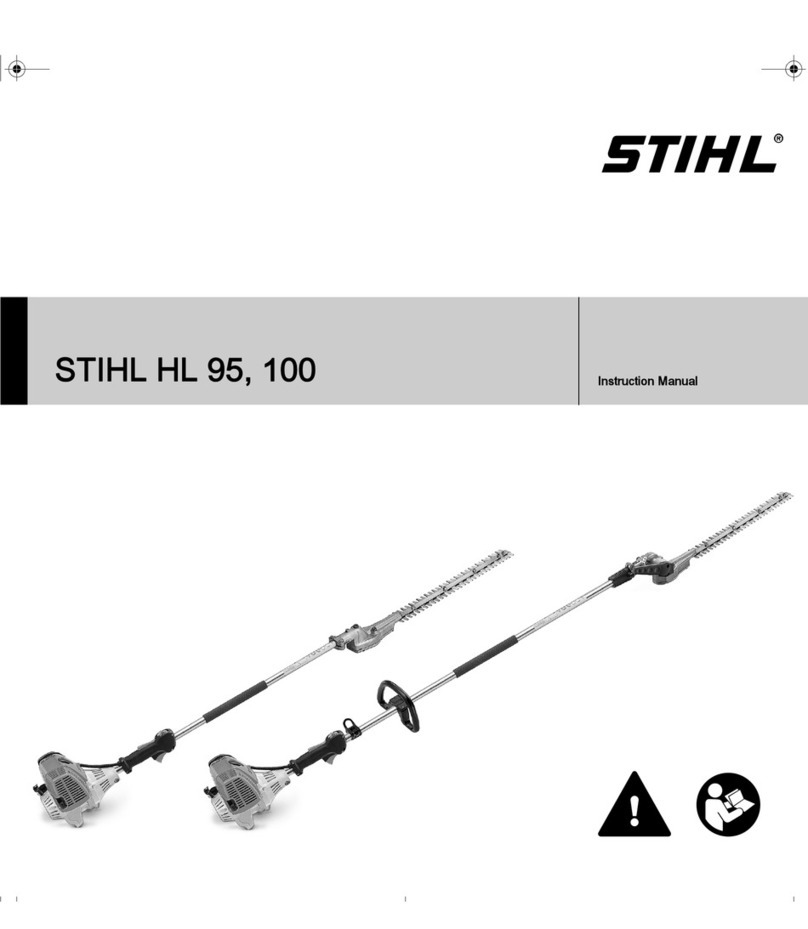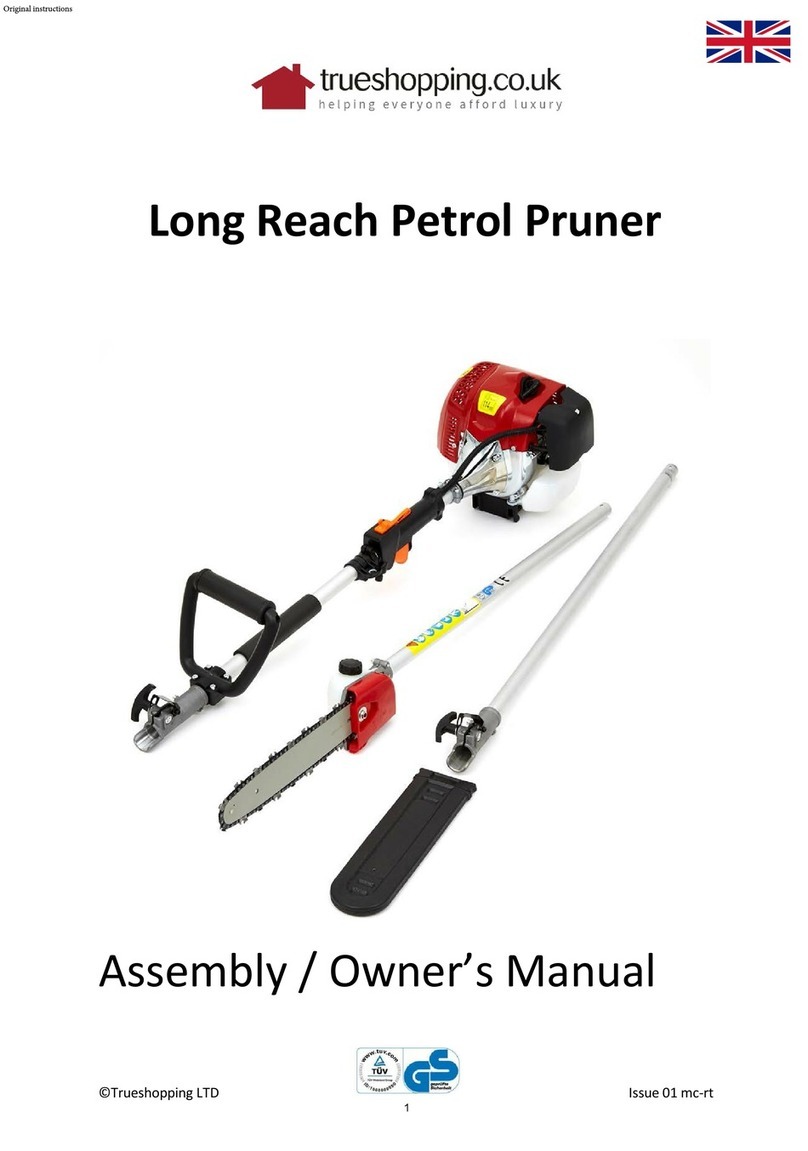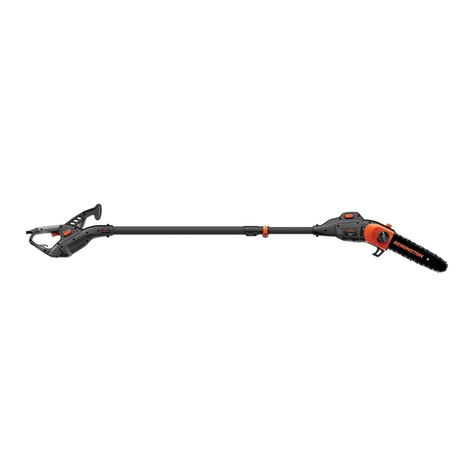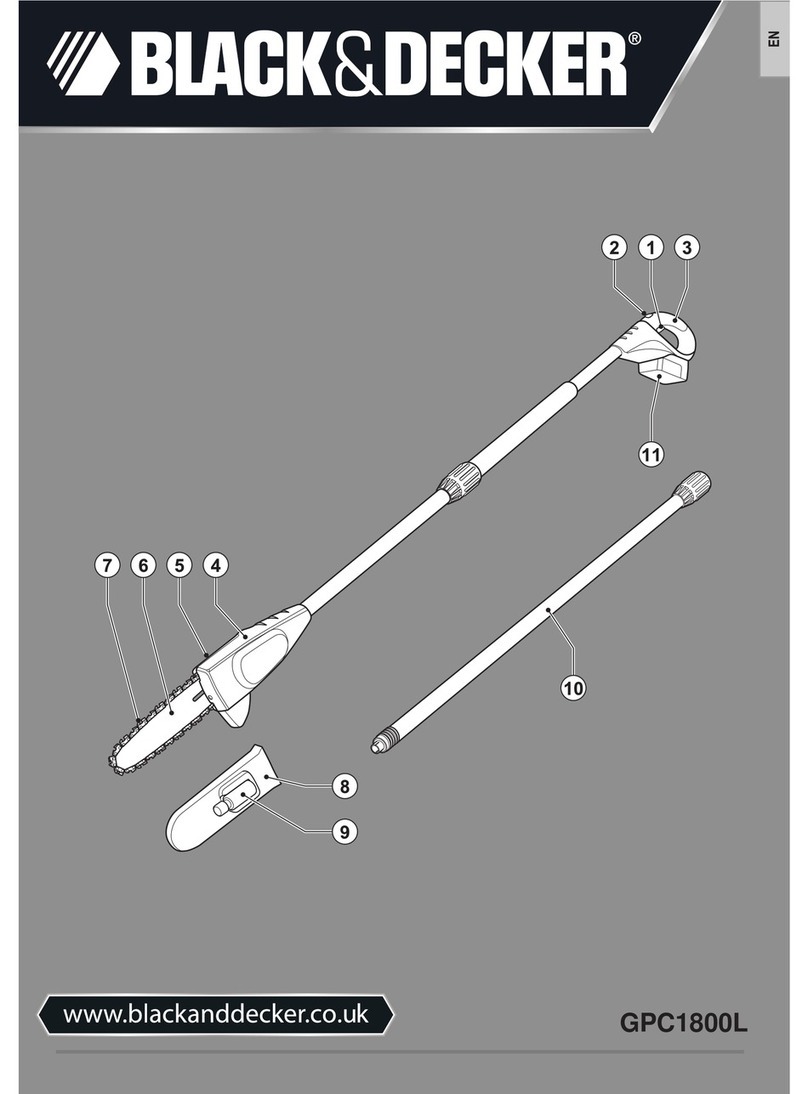Yard force AS C20 User manual

1
READ & UNDERSTAND
INSTRUCTION MANUAL
Save all warnings and instructions for future reference.
Hotline: +49 2154 82530002
Mail: [email protected]
www.yardforce.de
Sertronics GmbH
Niederlassung Saarlouis Ostring 60
Zufahrt “An der Fuchshöhle” 66740 Saarlouis-Fraulautern
POLE SAW HEAD
Original Instructions
GB
AS C20
M0L-10ET-200

2 3
Read this manual carefully prior to assembling and
operating the pole saw. It is dangerous to operate
this product without being familiar with these instructions.
Keep this manual in a safe place and have it ready for
future reference.
A
B
f
a
b
c
d
e
2
3
4
5
61

4 5
C
E
G
I
D
F
H
J
2mm
1
2
AS C20 Original Instructions
CONTENT
Intended use 08
General safety warnings 08
Product safety warnings 12
Symbols 17
Technical data 22
Description of product 23
Assembly 24
Operation 26
Maintenance and storage 29
Troubleshooting 31
CE declaration 32

6 7
INTENDED USE
This machine may only be used outdoors for cutting wood and in combination with the
original cutting chains.
This machine is not designed for heavy duty or commercial use.
This machine may only be used outdoors for cutting wood and in combination with the
original cutting chains.
This machine is not designed for heavy duty or commercial use.
Any use of the machine that deviates from its intended use and is not included in these
instructions is considered unauthorised use and relieves the manufacturer from his or her
legal liability.
GENERAL SAFETY WARNINGS
WARNING!
Read all safety warnings and all instructions.
Failure to follow the warnings and instructions may
result in electric shock, re and/or serious injury.
Save all warnings and instructions for future
reference.
The term “power tool” in the warnings refers
to your mains-operated (corded) power tool or
battery-operated (cordless) power tool.
Work area safety
1. Keep work area clean and well lit. Cluttered or dark
areas invite accidents.
2. Do not operate power tools in explosive atmospheres,
such as in the presence of ammable liquids, gases or
dust. Power tools create sparks which may ignite the
dust or fumes.
3. Keep children and bystanders away while operating a
power tool. Distractions can cause you to lose control.
Electrical safety
1. Power tool plugs must match the outlet. Never modify
the plug in any way. Do not use any adapter plugs with
earthed (grounded) power tools. Unmodied plugs
and matching outlets will reduce risk of electric shock.
2. Avoid body contact with earthed or grounded
surfaces, such as pipes, radiators, ranges and
refrigerators. There is an increased risk of electric
shock if your body is earthed or grounded.
3. Do not expose power tools to rain or wet conditions.
Water entering a power tool will increase the risk of
electric shock.
4. Do not abuse the cord. Never use the cord for
carrying, pulling or unplugging the power tool. Keep
cord away from heat, oil, sharp edges or moving
parts. Damaged or entangled cords increase the risk
of electric shock.
5. When operating a power tool outdoors, use an
extension cord suitable for outdoor use. Use of a cord
suitable for outdoor use reduces the risk of electric
shock.
6. If operating a power tool in a damp location is
unavoidable, use a residual current device (RCD)
protected supply. Use of an RCD reduces the risk of
electric shock.
NOTE: The term “residual current device(RCD)” may
be replaced by the term “ground fault circuit interrupter
(GFCI)” or “earth leakage circuit breaker(ELCB)”
GENERAL SAFETY WARNINGS

8 9
Personal safety
1. Stay alert, watch what you are doing and use common
sense when operating a power tool. Do not use a
power tool while you are tired or under the inuence of
drugs, alcohol or medication. A moment of inattention
while operating power tools may result in serious
personal injury.
2. Use personal protective equipment. Always wear eye
protection. Protective equipment such as dust mask,
non-skid safety shoes, hard hat, or hearing protection
used for appropriate conditions will reduce personal
injuries.
3. Prevent unintentional starting. Ensure the switch is in
the off-position before connecting to power source
and/or battery pack, picking up or carrying the tool.
Carrying power tools with your nger on the switch or
energising power tools that have the switch on invites
accidents.
4. Remove any adjusting key or wrench before turning
the power tool on. A wrench or a key left attached to
a rotating part of the power tool may result in personal
injury.
5. Do not overreach. Keep proper footing and balance at
all times. This enables better control of the power tool
in unexpected situations
6. Dress properly. Do not wear loose clothing or jewellery.
Keep your hair, clothing and gloves away from moving
parts. Loose clothes, jewellery or long hair can be
caught in moving parts.
7. If devices are provided for the connection of dust
extraction and collection facilities, ensure these are
connected and properly used. Use of dust collection
GENERAL SAFETY WARNINGS GENERAL SAFETY WARNINGS
can reduce dust-related hazards.
Power tool use and care
1. Do not force the power tool. Use the correct power
tool for your application. The correct power tool will
do the job better and safer at the rate for which it was
designed.
2. Do not use the power tool if the switch does not turn
it on and off. Any power tool that cannot be controlled
with the switch is dangerous and must be repaired.
3. Disconnect the plug from the power source and/or the
battery pack from the power tool before making any
adjustments, changing accessories, or storing power
tools. Such preventive safety measures reduce the
risk of starting the power tool accidentally.
4. Store idle power tools out of the reach of children and
do not allow persons unfamiliar with the power tool or
these instructions to operate the power tool. Power
tools are dangerous in the hands of untrained users.
5. Maintain power tools. Check for misalignment or
binding of moving parts, breakage of parts and any
other condition that may affect the power tool’s
operation. If damaged, have the power tool repaired
before use. Many accidents are caused by poorly
maintained power tools.
6. Keep cutting tools sharp and clean. Properly
maintained cutting tools with sharp cutting edges are
less likely to bind and are easier to control.
7. Use the power tool, accessories and tool bits etc. in
accordance with these instructions, taking into account
the working conditions and the work to be performed.

10 11
PRODUCT SAFETY WARNINGS
Use of the power tool for operations different from
those intended could result in a hazardous situation.
Service
Have your power tool serviced by a qualied repair
person using only identical replacement parts. This will
ensure that the safety of the power tool is maintained.
SPECIAL SAFETY INSTRUCTIONS FOR CORDLESS
POLE SAW
- Keep all parts of the body away when the saw is
operating. Before you start the pole saw, make sure
the saw chain is not touching anything. A moment
of inattention while operating pole saws may cause
entanglement of your clothing or body with the
chainsaw.
- Carry the chain saw by the front handle with the saw
chain stopped and the guide bar pointing to the rear.
When transporting or storing the chain saw always t
the guide bar cover. Proper handling of the chain saw
will reduce the likelihood of accidental contact with
the moving saw chain.
- Wear safety glasses and hearing protection. Further
protective equipment for head, hands, legs and feet
is recommended. Adequate protective clothing will
reduce personal injury by ying debris or accidental
contact with the saw chain.
- Do not operate a chain saw in a tree unless specically
trained to do so. Improper operation of a chain saw in
a tree, may result in personal injury.
PRODUCT SAFETY WARNINGS
- Always keep proper footing and operate the pole
saw only when standing on a xed, secure and level
surface. Slippery or unstable surfaces such as ladders
may cause a loss of balance or control of the pole
saw.
- When cutting a limb that is under tension be alert
for spring back. When the tension in the wood bers
is released the spring loaded limb may strike the
operator and/or throw the pole saw out of control.
- Use extreme caution when cutting brush and saplings.
The slender material may catch the saw chain and be
whipped toward you or pull you off balance.
- Carry the chain saw by the front handle with the chain
saw switched off and away from your body. When
transporting or storing the chain saw, always t the
guide bar cover. Proper handling of the chain saw will
reduce the likelihood of accidental contact with the
moving saw chain.Follow instructions for lubricating,
chain tensioning and changing accessories.
- Improperly tensioned or lubricated chain may either
break or increase the chance for kickback.
- Keep handles dry, clean, and free from oil and grease.
Greasy, oily handles are slippery causing loss of
control.
- Cut wood only. Do not use pole saw for purposes
not intended. For example: Do not use pole saw
for cutting plastic, masonry or non-wood building
materials. Use of the pole saw for operations different
than intended could result in a hazardous situation.
- This chain saw is not intended for tree felling. Use of
the chain saw for operations different than intended
could result in serious injury to the operator or

12 13
PRODUCT SAFETY WARNINGS
bystanders.
- Hold the chain saw by insulated gripping surfaces
only, because the saw chain may contact hidden
wiring or its own cord. Saw chains contacting a “live”
wire may make exposed metal parts of the chain saw
“live” and could give the operator an electric shock.
CAUSES AND OPERATOR PREVENTION OF
KICKBACK
1. KICKBACK may occur when the nose or tip of the
guide bar touches an object, or when the wood closes
in and pinches the saw chain in the cut.
2. Tip contact in some cases may cause a sudden
reverse reaction, kicking the guide bar up and back
towards the operator.
3. Pinching the saw chain along the top of the guide
bar may push the guide bar rapidly back towards the
operator.
4. Either of these reactions may cause you to lose control
of the saw which could result in serious personal
injury. Do not rely exclusively upon the safety devices
built into your saw. As a chain saw user, you should
take several steps to keep your cutting jobs free from
accident or injury.
5. Kickback is the result of tool misuse and/ or incorrect
operating procedures or conditions and can be
avoided by taking proper precautions as given below:
- Maintain a rm grip, with thumbs and ngers
encircling the chain saw handles, with both hands
on the saw and position your body and arm to
allow you to resist.
PRODUCT SAFETY WARNINGS
- Kickback forces. Kickback forces can be controlled
by the operator, if proper precautions are taken. Do
not let go of the chain saw.
- Do not over reach and do not cut above shoulder
height. This helps prevent unintended tip contact
and enables better control of the chain saw in
unexpected situations.
- Only use replacement bars and chains specied by
the manufacturer. Incorrect replacement bars and
chains may cause chain breakage and/or kickback.
- Follow the manufacturer’s sharpening and
maintenance instructions for the saw chain.
Decreasing the depth gauge height can lead to
increased kickback.
PRECAUTIONS FOR POLE SAW
1. Never stand directly under the limb you are cutting.
Always position yourself out of the path of falling
debris.
2. Never stand on a ladder or other type of unstable
support while using the pole saw.
3. Always use both hands to operate pole saw. Keep a
rm, steady pressure on the pole saw while cutting but
do not try to force the saw through the wood.
4. Do not use the pole saw to cut limbs larger in diameter
than the length of the guide bar.
5. Keep other people away from cutting end of pole saw
and at a safe distance from work area.
6. Do not use pole saw near cable, electric power or
telephone lines. Maintain a minimum clearance of 10
feet from all power lines.

14 15
PRODUCT SAFETY WARNINGS
Residual risks
Even when the tool is used as prescribed it is
not possible to eliminate all residual risk factors. The
following hazards may arise in connection with the tool’s
construction and design:
- Damage to lungs if an effective dust mask is not worn.
- Damage to hearing if effective hearing protection is
not worn.
- Health defects resulting from vibration emission if the
appliance is being used over longer periods of time or
not adequately managed and properly maintained.
WARNING! This machine produces an
electromagnetic eld during operation. This eld
may under some circumstances interfere with active or
passive medical implants.
To reduce the risk of serious or fatal injury, we
recommend persons with medical implants to consult
their physician and the medical implant manufacturer
before operating this machine.
SYMBOLS
Safety symbols
The purpose of safety symbols is to attract your attention
to possible dangers. The safety symbols and the
explanations with them require your careful attention
and full understanding. The symbol warnings do not, by
themselves, eliminate any danger. The instructions and
warnings they give are no substitutes for proper accident
prevention measures.
WARNING: Be sure to read and understand all safety
instructions in this operator’s manual, including all safety
alert symbols such as “DANGER,” “WARNING,” and
“CAUTION” before using this tool. Failure to follow all
instructions listed below may result in electric shock, re
and/or serious personal injury.
SAFETY ALERT SYMBOL: Indicates DANGER,
WARNING, or CAUTION. May be used in conjunction
with other symbols or pictographs.
Symbol meaning
This page depicts and describes safety symbols that may
appear on this product. Read, understand and follow
all instructions on the machine before attempting to
assemble and operate.

16 17
SYMBOLS
Please read all of the safety and operating
instructions carefully before using this machine.
Read the instruction manual before operating.
WARNING! Failure to follow the warnings and
instructions may result in electric shock, re and/
or serious injury.
Do not use this tool in the rain. Avoid using it in
damp conditions.
Wear eye protection.
Wear ear protection.
Wear safety helmet
Wear protective gloves
Wear proper safety shoes.
Danger-Keep hands away from blades. Contact
with blade will result in serious personal injury.
SYMBOLS
Keep all bystanders at least 50 ft.(15m) away.
Warning! The device is not protected against
electric shocks when it touches high-voltage
lines! Maintain a safe distance of 10m from live
electrical lines.
The product complies with the applicable
European directives, and an evaluation method of
conformity for these directives was done.
Sound level data (93 dB), in accordance with
Directive 2000/14/EC.
Waste electrical products should not be disposed
of with household waste. Please recycle where
facilities exist. Check your Local Authority or
retailer for recycling advice.
93

18 19
TECHNICAL DATA
Model AS C20
Main voltage 20V
Chain speed 320 m/min
Cutting length 20 cm
Oil tank 80 ml
Bar code 080SDEA041
Chain code 91P033X
Measured sound pressure level (LpA) 78 dB(A) K=2.0 dB(A)
Measured sound power level (LwA) 91 dB(A) K=2.0 dB(A)
Guaranteed sound power level (LwA) 93 dB(A)
Vibrations 1.5 m/s2, K=1.5 m/s2
Net weight 2.2 kg
The sound values have been determined according to noise test code given in EN
ISO 11680-1, using the basic standards EN ISO 11680-1.
The sound intensity level for the operator may exceed 80dB(A) and ear protection
measures are necessary.
The declared vibration value has been measured in accordance with a standard
test method (according to EN ISO 11680-1) and may be used for comparing one
product with another. The declared vibration value may also be used in a preliminary
assessment of exposure.
WARNING! Depending on the actual use of the product the vibration values can
differ from the declared total! Adopt proper measures to protect yourself against
vibration exposures! Take the whole work process including times the product is
running under no load or switched off into consideration!
Proper measures include among others regular maintenance and care of the
product and cutting attachments, keeping hands warm, periodical breaks and
proper planning of work processes!
DESCRIPTION OF PRODUCT
Parts description (Fig. A)
1. Bar sheath
2. Guide Bar
3. Saw Chain
4. Tension Wheel
5. Adjusting Wheel
6. Oil bottle cap
Delivery contents (Fig. B)
Carefully unpack the appliance and check that it is complete. Dispose of the packaging
material correctly.
a. Main pole pruner
b. Chain bar
c. Saw chain
d. Bar sheath
e. Instruction book
f. Chain oil
WARNING: If any parts are damaged or missing, do not operate this tool until these
parts are replaced. Failure to heed this warning could result in serious personal
injury.
NOTE: Always recycle the packaging in accordance with local recycling guidelines.

20 21
ASSEMBLY
Install the guide bar and saw chain
1. Position the chain saw power head on its side with the side cover facing upwards.
2. Turn the side cover knob anti-clockwise to remove the side cover and then loosen the
chain tensioning knob as much as possible. (Fig. C)
3. Lay the new saw chain in a loop on a at surface and straighten any kinks.
4. Place the chain drive links into the guide bar groove and make the chain a loop at the
back of the guide bar. (Fig. D)
5. Hold the chain in position on the guide bar and place the loop around the sprocket of the
power head. (Fig. E)
6. Slide the guide bar slot over the alignment anges until the tension adjusting pin is
inserted in the lower hole in the tail of the bar.
NOTE: Small directional arrows are engraved in the saw chain. Another directional arrow is
molded into the housing. When looping the saw chain onto the sprocket, make sure that the
direction of the arrows on the saw chain will correspond to the direction of the arrow on the
housing. If they face in opposite directions, turn over the saw chain and guide bar assembly.
7. Replace the side cover and slightly pre-tighten the side cover knob. (Fig. F)
8. Adjusting the chain tension
- Adjust the adjusting wheel in a clockwise direction, The drive links of a correctly
tensioned warm chain will hang approximately 2 mm out of the bar groove (Fig. G).
- Tighten the tension wheel. (Fig. H)
NOTE: New chains tend to stretch; check chain tension frequently and tension as required.
NOTE: A chain tensioned while it is warm may be too tight upon cooling. Check the cold
tension before next use.
Fitting the pole saw head. (Fig. I)
1. Insert the pole saw head into the pole socket.
2. Tighten the knob by turning clockwise.
Filling bar and chain lubricant (Fig. J)
WARNING: Do not smoke or bring any re or ame near the oil or the chain saw. Oil may spill
and cause a re.
NOTE: The chain saw is not lled with oil at the time of purchase. It is essential to ll the tank
with oil before use.
The chain is automatically lubricated with chain oil during operation.
1. Position the chain saw on its side with its oil tank cap facing towards.
2. Clean the cap as well as the area around and then turn it anti-clockwise to remove.
3. Carefully pour the specically designed oil into the tank until reaching the bottom of the
OPERATION
USING THE POLE SAW
Pruning
Warning! Always turn off the motor before laying down the machine!
Risk of recoil!
Recoil is caused by wood or other rm objects coming into contact with the top side or the
tip of the saw rail. This may cause the machine to be thrown back with force at the operator,
which may cause serious injuries.
Warning! Danger of injury!
Dangerous recoil may occur during the operation of the machine! This may cause serious
injuries or death!
Make absolutely sure that no wood or other rm objects can come into contact with the area
shown in the diagram on the right.
Only if you work carefully and properly can you reliably reduce the risk of recoil!
Pull sawing
This technique involves sawing with the bottom side of the saw rail from top to bottom. The
sawing chain pushes the machine forward away from the operator.
The front edge of the machine forms a support rest absorbing the forces caused by sawing
into a tree trunk.
Pull sawing allows the operator to exercise much more control over the machine and to
prevent it from recoiling. This is why you should make pull sawing the sawing technique of
your choice.
lter neck.
4. Wipe off any excessive oil and replace the cap.
NOTE: With upright position, oil should ll the inspection window. When the oil is no longer
visible in the inspection window, stop use immediately and rell.

22 23
Push sawing
This technique involves sawing with the top side of the saw rail from bottom to top. The
sawing chain pushes the machine backward toward the operator. If the saw rail becomes
jammed, the machine may be thrown back toward the operator with great force.
If the operator is unable to counterbalance the backward pushing force of the sawing chain
by his own body weight, only the tip of the sawing chain may be in contact with the wood,
which may cause a recoil.
Tree cutting
Note! Always work on the opposite side of the branch you want to cut down. Always start at
the bottom of the trunk and work your way up.
When removing larger branches, rst cut the branch from below (1).
Then cut through from above (2), and nally cut off the remaining branch (3).
Danger of injury. Branches that rest against a surface or are under tension may cause the
sawing chain to become jammed in the wood!
OPERATION
6
11 2 3
MAINTENANCE AND STORAGE
WARNING: When servicing, use only identical replacement parts. Use of any other parts may
create a hazard or cause product damage.
WARNING: Always wear protective gloves when performing any maintenance to the chain
saw.
WARNING: To avoid serious personal injury, remove the battery pack from the chain saw
before inspecting, cleaning, or performing maintenance. A battery operated tool with the
battery pack inserted is always on and can start accidently.
WARNING: When cleaning the chain saw, DO NOT immerse in water or other liquids.
WARNING: Do not at any time let brake uids, petrol, petroleum-based products, penetrating
oils, etc., come in contact with plastic parts. Chemicals can damage, weaken, or destroy
plastic, which may result in serious personal injury.
CLEANING
- After each use, clean debris from the chain and guide bar with a soft brush. Wipe the
chain saw surface with a clean cloth moistened with a mild soap solution.
- Remove the side cover, and then use a soft brush to remove debris from the guide bar,
saw chain, sprocket and side cover.
- Always clean out wood chips, saw dust, and dirt from the guide bar groove when
replacing the saw chain.
REPLACING THE BAR AND CHAIN
WARNING: Never touch or adjust the chain while the motor is running. The saw chain is very
sharp.
NOTE: When replacing the guide bar and chain, always use the specied bar and chain
combination listed in the manual.
Disassemble the Worn Bar and Chain
1. Remove the battery, allow the saw to cool and tighten the oil tank cap.
2. Position the chain saw on its side with the side cover facing upwards.
3. Wear gloves. Remove the side cover by turning the side cover knob anti-clockwise.
Clean the side cover with a dry cloth.
NOTE: This is a good time to inspect the drive sprocket for excessive wear or damage.
CHAIN MAINTENANCE
WARNING: Always wear gloves when handling the saw chain; these components are sharp
and may contain burrs.
Use only low-kickback chains on this saw. This fast cutting chain will provide kickback
reduction when properly maintained.
A properly sharpened saw chain cuts through wood effortlessly, even with very little pressure.
Never use a dull or damaged saw chain. A dull saw chain cutter leads to increased physical
strain, increased vibration load, unsatisfactory cutting results and increased wear.

24 25
MAINTENANCE AND STORAGE
For smooth and fast cutting, the chain needs to be maintained properly. The chain requires
sharpening when the wood chips are small and powdery, the chain must be forced through
the wood during cutting, or the chain cuts to one side. During maintenance of your chain,
consider the following:
- Improper ling angle of the side plate can increase the risk of a severe kickback.
- Raker (depth gauge) clearance. Too low increases the potential for kickback. Not low
enough decreases cutting ability.
- If cutter teeth have hit hard objects, such as nails and stones, or have been abraded by
mud or sand on the wood, have the chain sharpened by a qualied service technician.
NOTE: Inspect the drive sprocket for wear or damage when replacing the chain. If signs
of wear or damage are present in the areas indicated, have the drive sprocket replaced by
qualied service technician.
GUIDE BAR MAINTENANCE
When the guide bar shows signs of wear, reverse it on the saw to distribute the wear for
maximum bar life. The bar should be cleaned every day of use and checked for wear and
damage. Feathering or burring of the bar rails is a normal process of bar wear. Such faults
should be smoothed with a le as soon as they occur. A bar with any of the following faults
should be replaced.
- Wear inside the bar rails which permits the chain to lay over sideways.
- Bent guide bar.
- Cracked or broken rails.
- Spread rails.
In addition, the guide bar has a sprocket at its tip. The sprocket must be lubricated weekly
with a grease syringe to extend the guide bar life. Use a grease syringe to lubricate weekly
with chain oil by means of the lubricating hole. Turn the guide bar and check that the
lubrication holes and chain groove are free from impurities.
TRANSPORTING AND STORING
- Do not store or transport the chain saw when it is running. Always remove the battery
pack before storing or transporting.
- Always place the guide bar sheath on the guide bar and chain before storing or
transporting the chain saw. Use caution to avoid the sharp teeth of the chain.
- Clean the chain saw thoroughly before storing. Store the chain saw indoors, in a dry
place that is locked and/ or inaccessible to children.
- Keep away from corrosive agents such as garden chemicals and de-icing salts.
TROUBLESHOOTING
WARNING!
Before performing any repair work, always remove the battery pack.
Caution!
Improper repairs can result in the product functioning unsafely. This endangers
yourself and your environment.
Faults which cannot be rectied with the aid of following table may be rectied by
a specialist company only (customer service center).
Please be aware that any improper repairs will also invalidate the warranty and
additional costs may be incurred.
Use only genuine spare parts. Only these spare parts are designed and suitable for
the product. The use of other spare parts not only voids the warranty, you can also
endanger yourself and your environment.
Fault Possible cause Solution
Product is not
running.
Battery low? Charge the battery pack.
Battery pack does not sit its
place correctly
Install the battery pack once
again
Device defective? Contact service partner.
Chain not cutting
properly
Incorrectly mounted saw chain Mount saw chain correctly
Saw chain blunt Sharpen cutting teeth or replace
with new chain
Chain tension insufcient Check chain tension
Bar and chain
running
hot and smoking.
Too little oil Check bar lube reservoir, where
appropriate, rell with oil
Tension over tightened Tension chain. Refer to Chain
Tension in this manual

26
To the provisions of Council Directives
We
MEROTEC GmbH,
Otto-Brenner-Straße 8, 47877 Willich/ Deutschland
Declare that the product:
Machine Description: 20V Pole Saw
AS C20 / M0L-10ET-200
Function: Cutting Log
Complies with the essential health and safety requirements of the following directives:
Machinery Directive 2006/42/EC
Electromagnetic Compatibility Directive 2014/30/EC
EC Directive 2011/65/EU and its amendment Directive (EU) 2015/863 (RoHS) *)
Noise Emission in the Environment by Equipment for Use Outdoors Directive
2000/14/EC amended by 2005/88/EC
We additionally conrm the following in accordance with the 2000/14/EC Annex VI amended
by 2005/88/EC emissions guideline,
Measured Sound Power Level: 91 dB(A) K=2 dB(A)
Declared Guaranteed Sound Power Level: 93 dB (A)
Standards and technical specification referred to :
EN 60745-1: 2009+A11:10
EN ISO 11680-1: 2011
EN 55014-1: 2006/ A1:2009/+A2:2011
EN 55014-2: 2015
EN 50581: 2012
Authorized Signatory
Date: 24.03.2020
Signature:________________________
Place: Willich
Name: Roland Menken
General Manager
MEROTEC GmbH,
Otto-Brenner-Straße 8, 47877 Willich
Deutschland
*) The object of the declaration described above satises the provisions of directive 2011/65/
EU of the European Parliament and the Council of 8 June 2011 on limiting the use of certain
harmful substances in electrical and electronic appliances.
CE DECLARATION
This manual suits for next models
1
Table of contents
Other Yard force Pole Saw manuals
Popular Pole Saw manuals by other brands

909
909 PH1000 instruction manual

Bushranger
Bushranger TPS261 Owner's/operator's manual
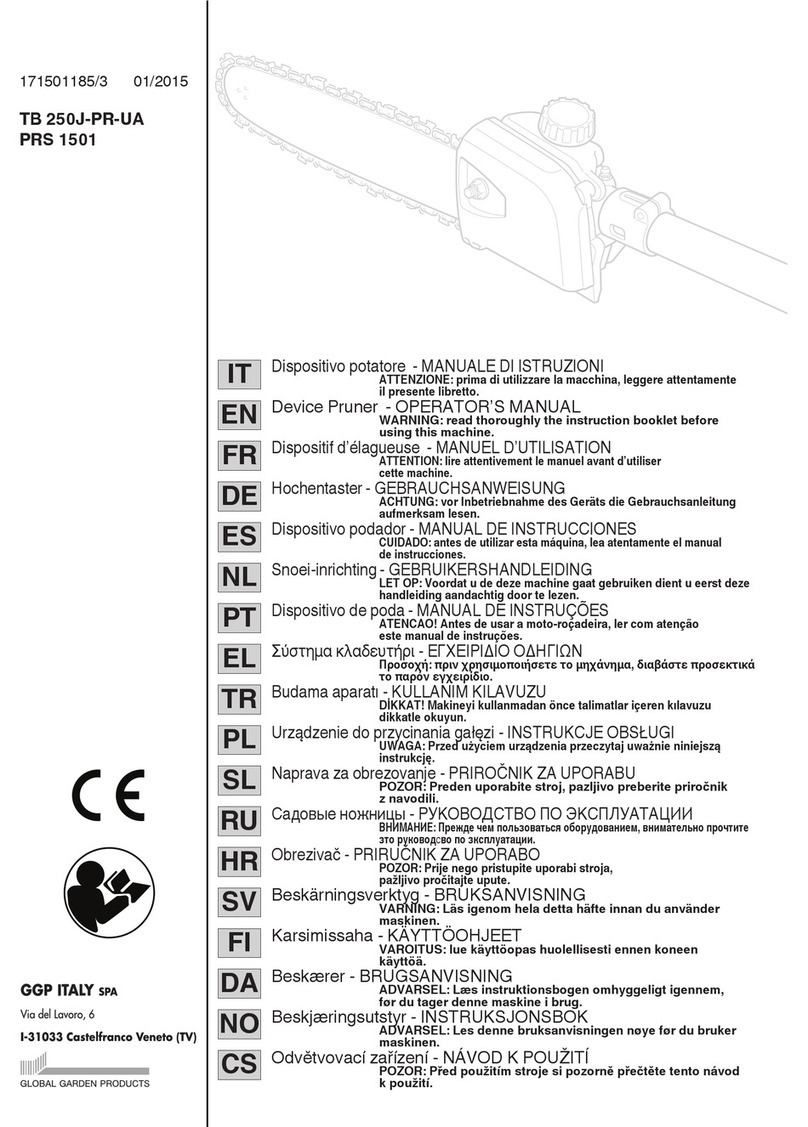
GGP ITALY
GGP ITALY TB 250J-PR-UA Operator's manual

Spear & Jackson
Spear & Jackson S75EC2 Original instruction manual
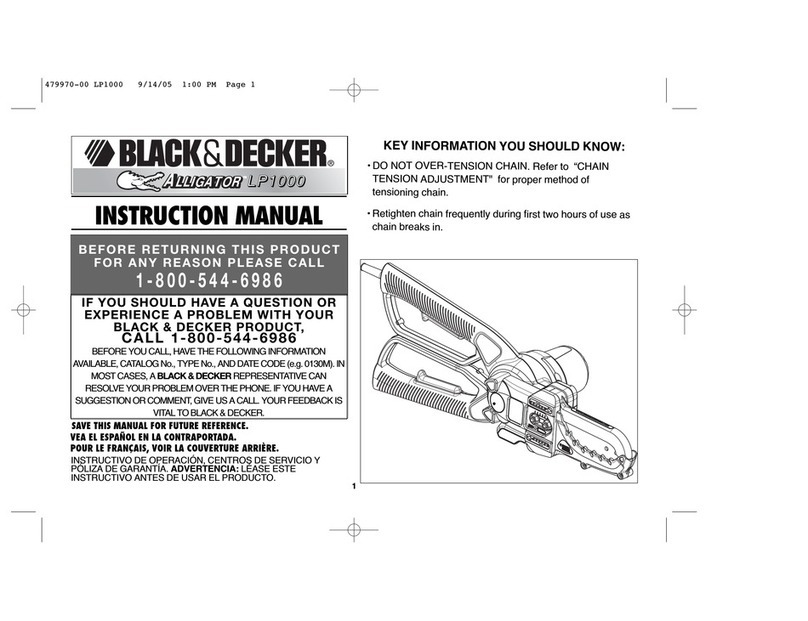
Black & Decker
Black & Decker Alligator 479970-00 instruction manual
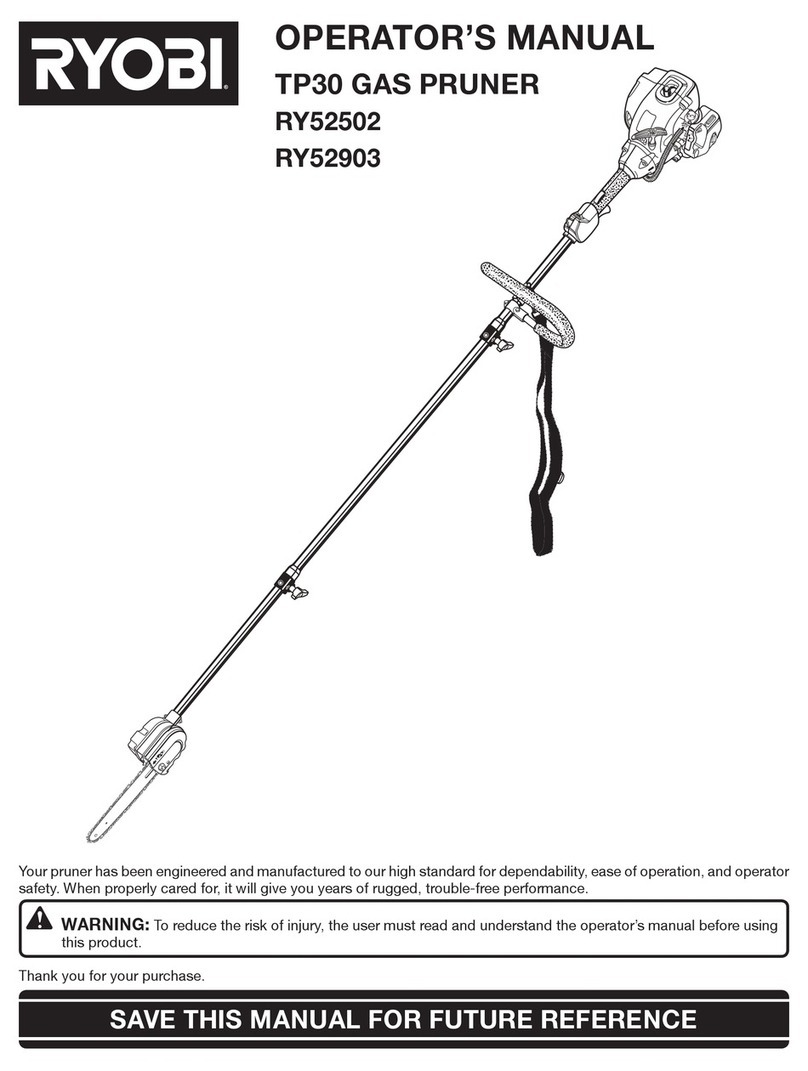
Ryobi
Ryobi RY52502 Operator's manual

